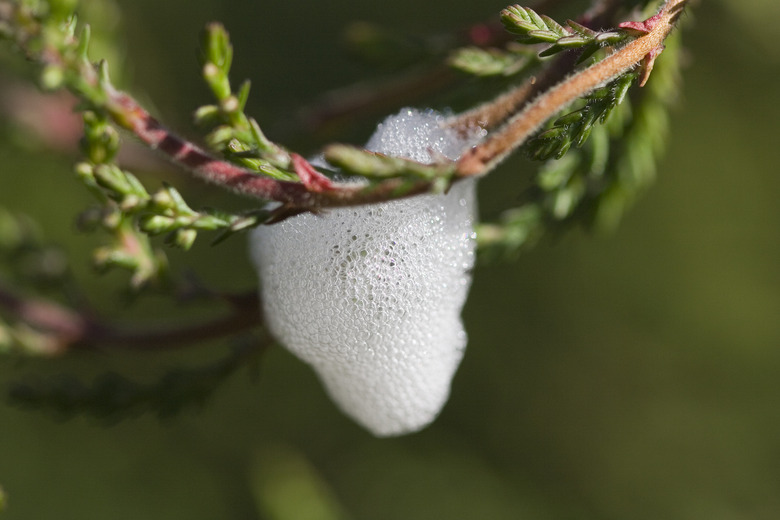What Is The Spit-Looking Substance On My Grass?
Foamy masses of spitlike bubbles on grass stems are produced by immature froghoppers, or spittlebugs. The adult insects resemble shorter, wider versions of leafhoppers. Many kinds of spittlebugs exist, but the species that feeds on grass is the twolined spittlebug. The adults are dark brown to black, and most have two orange or red stripes across their outer wings. The insects use their piercing, sucking mouth parts to feed on the sap of grasses and other plants in the U.S. East and Midwest.
Foam Production
Foam Production
Only spittlebug nymphs make the foam. As a nymph feeds on grass sap, extra sap passes through its digestive system and exits at the tip of its abdomen. The extra sap, or exudate, mixes with secretions from special glands in the nymph. The secretions thicken and stabilize the foam, preventing it from breaking down quickly. The extra sap is forced out of the nymph under pressure, and the sap mixes with air, creating the bubbles. The nymph draws the bubbles upward and over its back with its legs. The foam helps to keep the soft-bodied, yellowish nymph from drying out and helps conceal it from parasites and predators.
Spittlebug Stages
Spittlebug Stages
Adult female spittlebugs lay their eggs in plant stems, debris or behind grass leaf sheaths in fall. The eggs overwinter and hatch in spring. The tiny nymphs find a grass stem and begin feeding and creating foam. They molt four times, shedding their outer skin with each molt. At the final molt, they turn into winged adults, usually in late spring or early summer. Two generations of spittlebugs can occur in one year.
Grass Damage
Grass Damage
Although both spittlebug nymphs and adults feed on grass, the nymphs cause more damage because they take out extra sap to make the foam. Look for the foam near the soil surface or in the thatch of turf grass; parting the grass may be necessary to see the foam. Another symptom of spittlebug infestation is a purple or white stripe that runs along the grass blade of a stem fed on by spittlebugs. When many spittlebugs are in grass, the blades wilt and their tips may turn yellow then brown.
Prevention
Prevention
Keeping lawn grass properly irrigated, fertilized and mowed can prevent spittlebugs from affecting it. Don't keep the grass too moist because spittlebugs prefer wet conditions. Getting rid of thatch buildup reduces spittlebug populations. Choose spittlebug-resistant grass cultivars, such as zoysiagrass (Zoysia spp.), hardy in U.S. Department of Agriculture plant hardiness zones 5 through 10, and St. Augustinegrass (Stenotaphrum secundatum), hardy in USDA zones 8 through 10. Avoid centipedegrass (Eremochloa ophiuroides), which is more easily damaged by spittlebugs. It is hardy in USDA zones 7 through 10.
